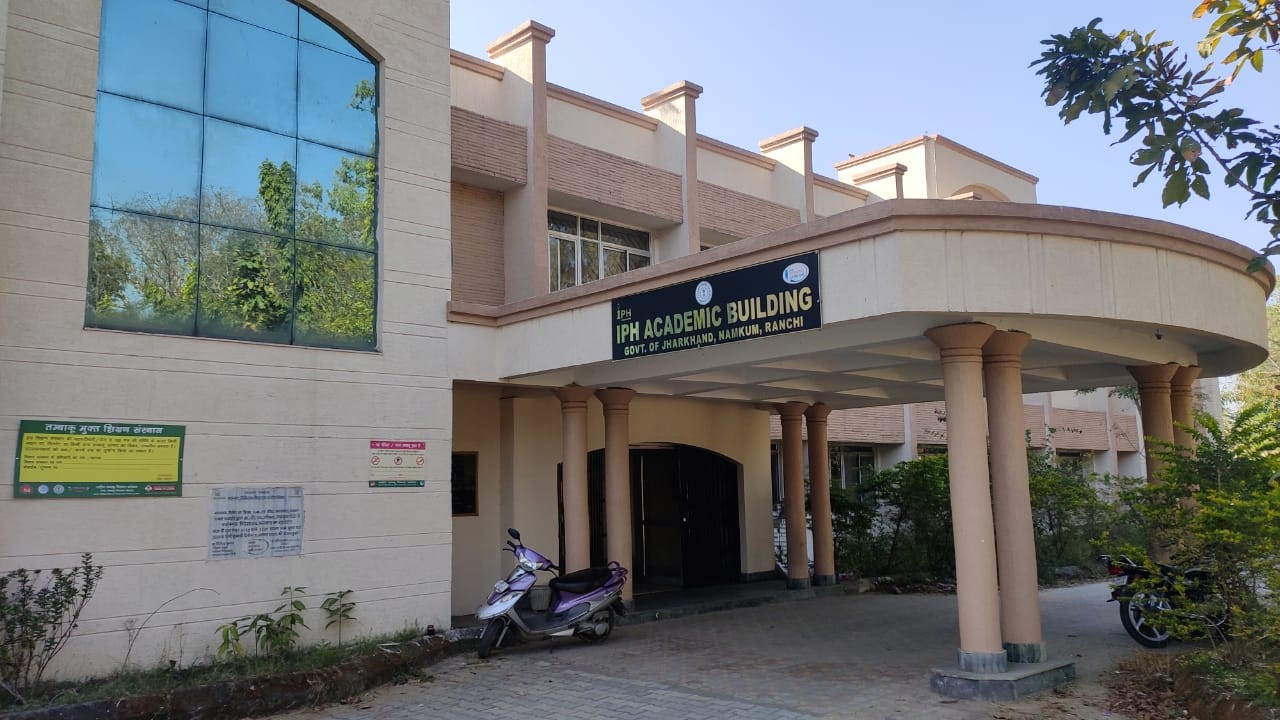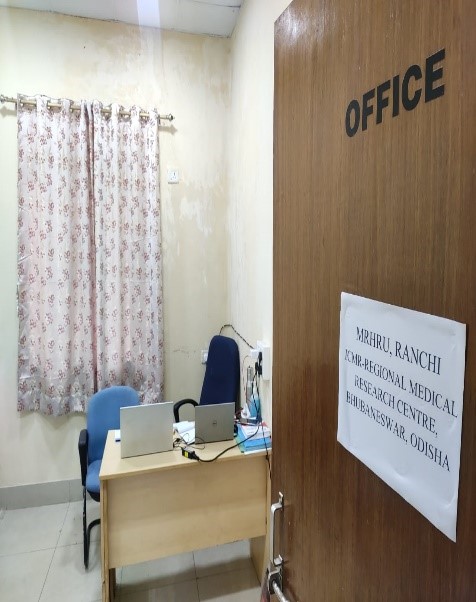Model Rural Health Research Units (MRHRU)
INTRODUCTION:
Government of India, in June’2013, approved the scheme for ‘Establishment of Model Rural Health Research Units (MRHRUs) in the States’ during the 12th plan period as a path breaking initiative to develop & strengthen the health research infrastructure in the country. The scheme will demonstrate how the modern technologies and research, which are struck up at the national level centres/Medical Colleges, can be transferred and used in the rural settings for providing better health care to the population. MRHRU at Tigiria, Odisha has been set up in the campus of CHC Tigiria of district Cuttack, Odisha.
A Memorandum of Understanding (MOU) was signed between Department Of Health Research, Govt. of India and Department of Health and family welfare, Govt. of Odisha on 15th September 2014. In rural three tiers system of health, Community Health Centre (CHC) is coined as providing higher level of health services. Due to increase in incidence of Chronic Kidney Disease (CKD), leprosy, malaria and diabetes in Tigiria block along with the nearby villages, it was planned to establish MRHRU at Tigiria with the collaboration of Department of Health & Family Welfare, Govt. of Odisha, Department of Health Research, ICMR- Regional Medical Research Centre, Bhubaneswar, Sriram Chandra Bhanja (SCB) Medical College, Cuttack.
OBJECTIVES:
- Create infrastructure at the periphery for transfer of technology to the rural level for improving the quality of health services to rural population.
- To ensure an interface between the new technology developers (researchers in the medical institution; state or centre), health system operators (centre or state health services) and the beneficiaries (communities in rural areas).
- Ensure the much needed geographical spread of health research infrastructure in the country.
FUNCTIONS OF MRHRU, TIGIRIA:
- To develop State/area specific models depending upon the disease profile, topography, morbidity patterns and local conditions for transfer of the technology for providing better health care services to the rural masses by supporting and undertaking relevant research on local health issues as per the priorities identified by the State Govt. in close coordination with State health authorities. Special focus will be given to tribal areas, hilly terrain, and remote areas.
- To create a state-wide research capability within the context of building the National Research Infrastructure, including training the health professionals of State Health System to enable them to carry out health research in the use of modern technologies and to replicate the models at local level.
- To facilitate the transfer of appropriate technologies, existing and new, to make them available and accessible to target populations.
- To undertake various research projects in close coordination with the State Government Institutions and others that are relevant and beneficial to the rural population.
HEALTH CARE FACILITIES ADJACENT TO THE FACILITY:
No. of Community Health Centre (CHC): 2
- Tigiria
- Bindhanima
No. of Primary Health Centre (PHC): 4
- Anchalkota
- Bhiruda
- Nuapatna Town
- Badanauput
No. of Sub centre (SC): 13
- Anchalkota
- Bhiruda
- Panchagaon
- Tigiria
- Nuapatna
- Bindhanima
- Puruna Tigiria
- Basudevpur
- Kalibiri
- Badanauput
- Khandahata
- Koili Kanya
- Bishnupur
PRESENT ACTIVITES AT THE MRHRU, TIGIRIA:
The MRHRU at Tigiria, Cuttack is currently functional with in positioned all human resource, a good laboratory facility, infrastructural facility and all other essential equipment and necessary commodities. Currently, through the centre, several different research projects are ongoing in the centre and some of them are successfully completed. The centre works in close collaboration with the health care facilities and the catchment community. Apart from carrying out research projects, the centre is actively involved in various community level health awareness activities and programmes. The centre has constituted a Community Advisory Board (CAB) for better implementation of ongoing and upcoming research projects. The center has prioritized for the research projects of local importance such as CKD, MCH, Dengue and Chikungunya.
ONGOING PROJECTS:
- Community based Surveillance to estimate incidence and sero prevalence of Acute Febrile Illness (AFI) with focus on Dengue and Chikungunya A prospective multi centric cohort study: The project involves gathering data and conducting research within communities. This approach typically involves working closely with local healthcare providers, community health workers, and residents to monitor and track cases of AFI. The project aims to determine both the incidence (rate of new cases) and sero-prevalence (the proportion of people in a population who have antibodies against a particular infection) of Dengue and Chikungunya within the studied communities. This project appears to be focused on epidemiological research to better understand the burden of Dengue and Chikungunya in specific communities. The data collected can be used for disease surveillance, informing public health policies, and guiding interventions to reduce the impact of these mosquito-borne diseases on community health. Additionally, it may contribute to our understanding of the broader field of infectious disease epidemiology.
- Integrated-Palliative care, Elderly care and Mental Health (I-PEM): Staff has been recruited under the project and currently training has been given to the staff for use of REDCAP application during the data collection. Meeting has been conducted with FHW, CHO, SARAPANCHA & ASHA of selected sites for smooth activity and support during the data collection. Several virtual meetings have been conducted by the DHR – IPEM team for induction and project implementation. Data collection has been started in recent.
- Demography Integrated Surveillance for Health Assessment (DISHA) on Dengue and Chikungunya in Tigiria block of Cuttack district, Odisha - A pilot study: Under the project, all the 50 villages in the Tigiria block of Cuttack district are covered. Till date, village boundary demarcation, household survey, land parcel mapping and line listing have been done. A total of 19653 LPs are mapped and census enumerations of 76261 individuals have been completed so far. In order to achieve the project targets, training programs, community awareness campaigns, stakeholder meetings were organized. Under the project, all preparations are done to carry out the AFI surveillance for Dengue and Chikungunya.
- Strengthening cause of death statistics: A study in select ICMR Model Rural Health Research Units (MRHRU) Districts in three States in India: Staff has been recruited under the project and virtual meetings have been conducted by the DHR – CoD project team for induction and project implementation plan. Discussed with the CDMO for extended support under the project activities. Data collection has been started in recent. Translation of PIS, CONSENT, KEY INFORMANT has been done. List of selected interview participants for IDI has been done & mock interview (IDI) practiced has been completed. Data collection will be started soon.
- Laboratory surveillance system for antimicrobial resistance in community settings and understanding the perception and determinants leading to antimicrobial (mis)use in rural settings of Odisha & Chhattisgarh: Total of 1003 study participants were enrolled from the households of 30 villages. For qualitative baseline survey we have conducted 18 in-dept interviews (IDIs) with clinicians, pharmacists, nurses, poultry farmers, veterinary doctors, drug sellers or chemist and 1 focus group discussions (FGDs) with community health workers (ASHA workers)
- Immune status against SARS-CoV-2 among COVID-19 vaccinated adults in India: A health facility-based multi-centric serial cross-sectional survey: The primary focus of this project is to evaluate the immune status of individuals who have received COVID-19 vaccinations. This likely involves measuring the presence of antibodies against the SARS-CoV-2 virus, which causes COVID-19, to determine the level of immunity among vaccinated individuals. The project is specifically targeting adults who have received one or more doses of COVID-19 vaccines. Assessing the immune response in this group is important for understanding the effectiveness of vaccination programs and any potential waning immunity over time.
COMPLETED PROJECTS:
- Short term assessments to inform accelerated distribution, uptake, and promotion of increased use of Liquefied Petroleum Gas (LPG) through Pradhan Mantri Ujjwala Yojna (PMUY): A total of over 450 participants per group (LPG users vs. LPG non-users) were studied to assess their health status and determine any association with the cooking source with disease. We found that women who adopted LPG exclusively (at least from past one year) were having lower disease burden when compared with low or non-users. Women who adopted LPG exclusively (at least from past one year) had better quality of life score when compared with low or non-users.
- Surveillance of Enteric Fever in Rural Area: A hospital based tier-II surveillance in the catchment area of Tigiria block, Cuttack, Odisha: This study was done as a part of hospital-based Tier – II Surveillance for enteric fever. Under the study, a total of 715 samples were collected, of which 106 samples showed bacterial growth. Upon further testing, two samples were found to be positive for S. typhi. Under the study, capacity building & stakeholder meetings were conducted quarterly. Data were collected using standardized web designed platform using Open Data Kit tool. A total of 1015 samples were collected (445 samples from SDH Athagarh, 411 samples from CHC Bindhanima and 159 samples from CHC Tigiria) out of which 137 samples showed bacterial growth. Out of total culture positive samples, 123 were Gram-positive bacteria and 14 were Gram-negative bacteria among which two were identified as S. typhi. Looking at such low prevalence enteric fever cases, we decided to carry out Widal test for the samples additionally. Out of 788 patients who were tested for Widal status, 439 samples were found to be positive for Widal test, whereas 349 were Widal negative.
- Assessment of health status of the elderly population in Tigiria: A Syndemic approach: The study included a total of 725 rural older adults. Among them, 47.9% (n=347) were female and the rest male. The age distribution of the participants was normal and the mean age was 70.24 years (SD=8.37 years), and ranged between 60 and 106 years. The overall prevalence of multi morbidity was 48.8% (CI= 45.1-52.5%; n=354) and among them dyads were most common (25%; CI-21.8-28.2%) followed by triads (15.2%; CI:12.6-17.9%). Four or more chronic diseases were seen in 63 persons (8.7%; CI: 6.7-10.9%). Among the study participants, 18.2% (n=132; CI: 15.4-21.2%) had no chronic disease and 33.0% (n=239; CI: 29.5-36.5%) had a single chronic disease.
- Mobile Application for Immunization Data in India (MAIDI): The project was implemented in Adaspur block of Cuttack district, Odisha. To understand the immunization coverage, a pre-situational analysis was done in the study site using the secondary data. MAIDI was mobile based innovative software done at ICMR head quarter and piloted in 6 field sites across the country. Through the project, front line health care providers (ASHA, ANM) were trained on use of digital data collection platform and use the MAIDI application using smart phone device. The MAIDI application was found to have better acceptability and adherence. This application can be integrated with the existing platforms to strengthen the Immunization documentation.
PUBLICATIONS SO FAR:
- Samal, M., Sahoo, K. C., Pati, S., Tripathy, S. R., Parida, M. K., & Das, B. K. (2020). Use of animal and animal products for rheumatoid arthritis treatment: an explorative study in Odisha, India. Frontiers in Medicine, 6. https://doi.org/10.3389/fmed.2019.00323
- Palo, S. K., Patel, K., & Pati, S. (2020). Situation of labour room documentation at secondary level public health facilities of Cuttack district, Odisha, India – A SWOT analysis. Journal of Family Medicine and Primary Care, 9(7), 3308. https://doi.org/10.4103/jfmpc.jfmpc_376_20
- Kshatri, J. S., Palo, S. K., Bhoi, T., Barik, S. R., & Pati, S. (2020). Associations of multimorbidity on frailty and dependence among an elderly rural population: Findings from the AHSETS study. Mechanisms of Ageing and Development, 192, 111384. https://doi.org/10.1016/j.mad.2020.111384
- Kshatri, J. S., Palo, S. K., Bhoi, T., Barik, S. R., & Pati, S. (2020a). Prevalence and patterns of multimorbidity among rural elderly: findings of the AHSETS study. Frontiers in Public Health, 8. https://doi.org/10.3389/fpubh.2020.582663
- Kshatri, J. S., Bhoi, T., Barik, S. R., Palo, S. K., & Pati, S. (2021). Is multimorbidity associated with risk of elder abuse? Findings from the AHSETS study. BMC Geriatrics, 21(1). https://doi.org/10.1186/s12877-021-02347-y
- Rana, K., Nayak, S. R., Bihary, A., Sahoo, A. K., Mohanty, K. C., Palo, S. K., Sahoo, D., Pati, S., & Dash, P. (2021). Association of quorum sensing and biofilm formation with Salmonella virulence: story beyond gathering and cross-talk. Archives of Microbiology, 203(10), 5887–5897. https://doi.org/10.1007/s00203-021-02594-y
- Palo, S. K., Kanungo, S., Samal, M., Priyadarshini, S., Sahoo, D., & Pati, S. (2021). Water, Sanitation, and Hygiene (WaSH) practices and morbidity status in a rural community: findings from a cross-sectional study in Odisha, India. PubMed, 62(2), E392–E398. https://doi.org/10.15167/2421-4248/jpmh2021.62.2.1503
- Sahoo, K. C., Dash, G. C., Panda, S., Kshatri, J. S., Uddin, A., Pattnaik, M., Sahoo, R. K., Diwedi, R., Palo, S. K., Bhattacharya, D., & Pati, S. (2022). Impact of smokeless cooking fuel use on health status of women in a rural setting of eastern India. International Journal of Environmental Health Research, 33(5), 464–472. https://doi.org/10.1080/09603123.2022.2035324
- Dash, P., Mansingh, A., Nayak, S. R., Sahoo, D., Bhattacharya, D., Kanungo, S., Kshatri, J. S., Mishra, B. K., Pattnaik, M., Parai, D., Choudhury, H. R., Nayak, S., Rana, K., Alce, A., Sahoo, A. K., Mohanty, K. C., Mohanty, P., Doley, C., Jain, H. K., . . . Palo, S. K. (2022). Infection, cases due to SARS-CoV-2 in rural areas during early COVID-19 vaccination: Findings from sero-survey study in a rural cohort of eastern India. Epidemiology and Infection, 150. https://doi.org/10.1017/s0950268822000346
- Mohanty, N. K., Sahoo, K. C., Pati, S., Sahu, A. K., & Mohanty, R. (2020). Prevalence of chronic kidney disease in Cuttack district of Odisha, India. International Journal of Environmental Research and Public Health, 17(2), 456. https://doi.org/10.3390/ijerph17020456 .
- Nayak, S., Nayak, S. R., Alice, A., Sahoo, D., Kanungo, S., Rehman, T., Pati, S., & Palo, S. K. (2023). Factors associated with poor self-rated health among chronic kidney disease patients and their health care utilization: Insights from LASI wave-1, 2017-18. Frontiers in Nephrology, 2. https://doi.org/10.3389/fneph.2022.968285
- Pattnaik, M., Nayak, A. K., Karna, S., Sahoo, S. K., Palo, S. K., Kanungo, S., Kshatri, J. S., Parai, D., Walia, K., Singh, T., Choudhary, H. R., Pati, S., & Bhattacharya, D. (2023). Perception and determinants leading to antimicrobial (mis)use: A knowledge, attitude, and practices study in the rural communities of Odisha, India. Frontiers in Public Health, 10. https://doi.org/10.3389/fpubh.2022.1074154
- Nayak, S., Rehman, T., Patel, K., Dash, P., Alice, A., Kanungo, S., Palo, S. K., & Pati, S. (2023). Factors Associated with Chronic Kidney Disease of Unknown Etiology (CKDu): A Systematic Review. Healthcare, 11(4), 551. https://doi.org/10.3390/healthcare11040551
- Sharma, N., Palo, S. K., Bhimarasetty, D. M., Kandipudi, K. L. P., Purty, A. J., Kumar, T., Basu, S., Alice, A., Velavan, A., Madhavan, S., Rongsen-Chandola, T., Arora, N. K., Dixit, S., Pati, S., & Malik, S. T. (2023). Community Dynamics and Engagement Strategies in Establishing Demographic Development and Environmental Surveillance Systems: A Multi-Site Report from India. Healthcare, 11(3), 411. https://doi.org/10.3390/healthcare11030411
- Dash, P., Mohapatra, S. R., & Pati, S. (2022). Metabolomics of Multimorbidity: Could it be the Quo vadis? Frontiers in Molecular Biosciences, 9. https://doi.org/10.3389/fmolb.2022.848971
- Dash, P., Rana, K., Turuk, J., Palo, S. K., & Pati, S. (2023). Antimicrobial Resistance and Biofilm Formation of Staphylococcus aureus Isolates from Febrile Cases: Findings from a Rural Cohort of Odisha, India. Polish Journal of Microbiology, 72(2), 209–214. https://doi.org/10.33073/pjm-2023-005
- Palo, S. K., Nayak, S. R., Sahoo, D., Nayak, S., Mohapatra, A. K., Sahoo, A., Dash, P., & Pati, S. (2023). Prevalence and pattern of multimorbidity among chronic kidney disease patients: a community study in chronic kidney disease hotspot area of Eastern India. Frontiers in Medicine, 10. https://doi.org/10.3389/fmed.2023.1131900
IMAGE GALLERY:
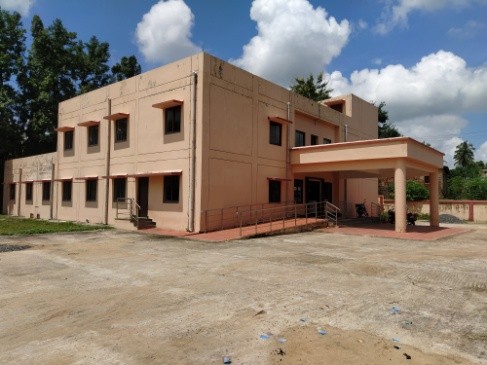
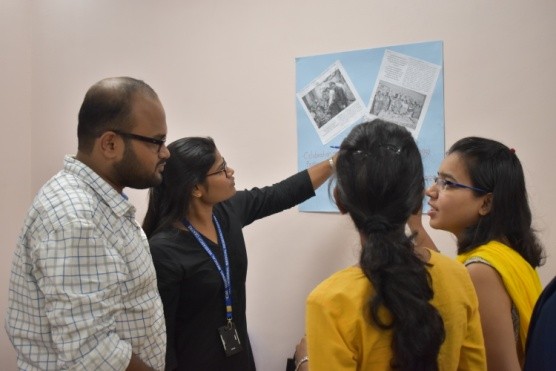
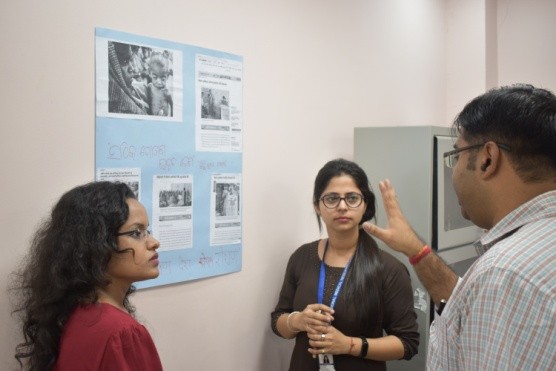
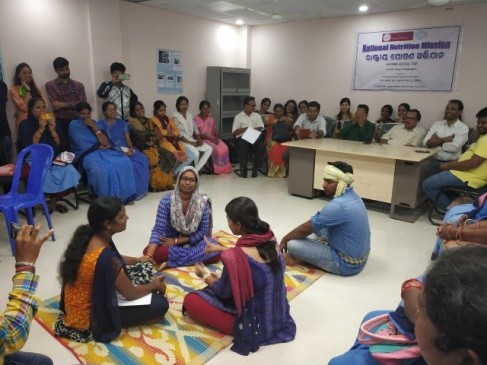
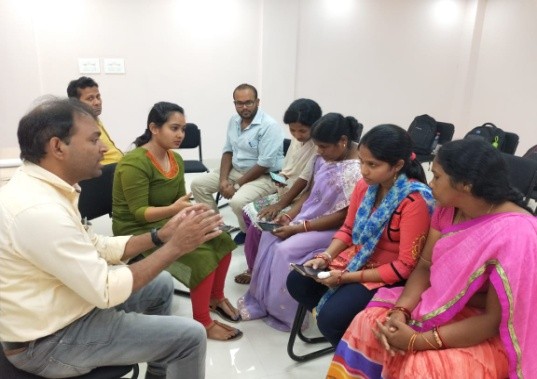
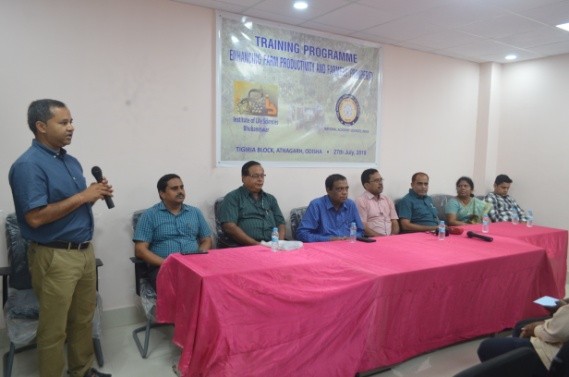
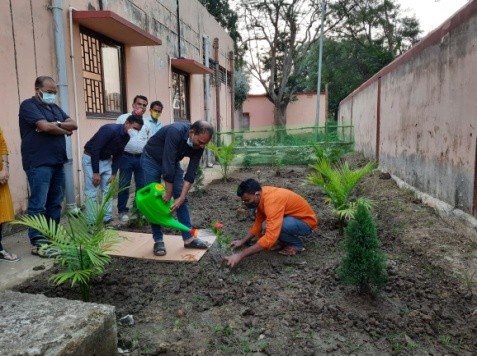
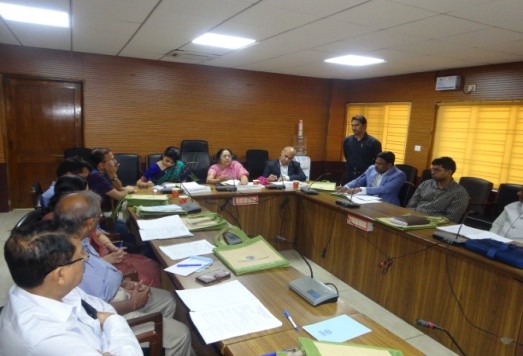
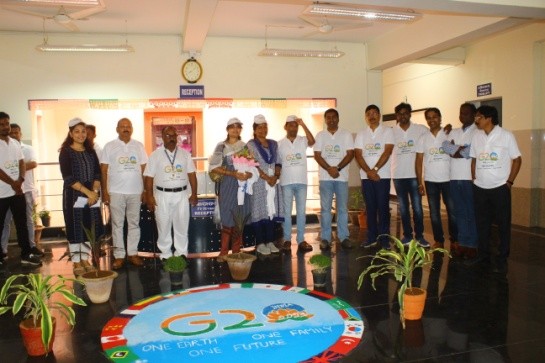
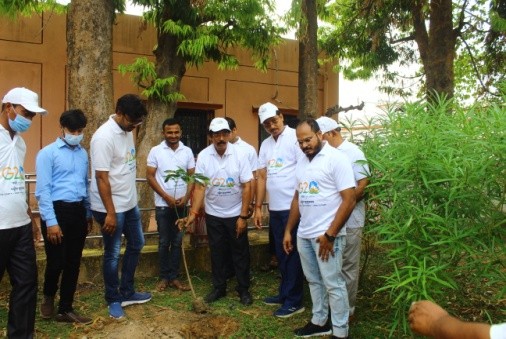
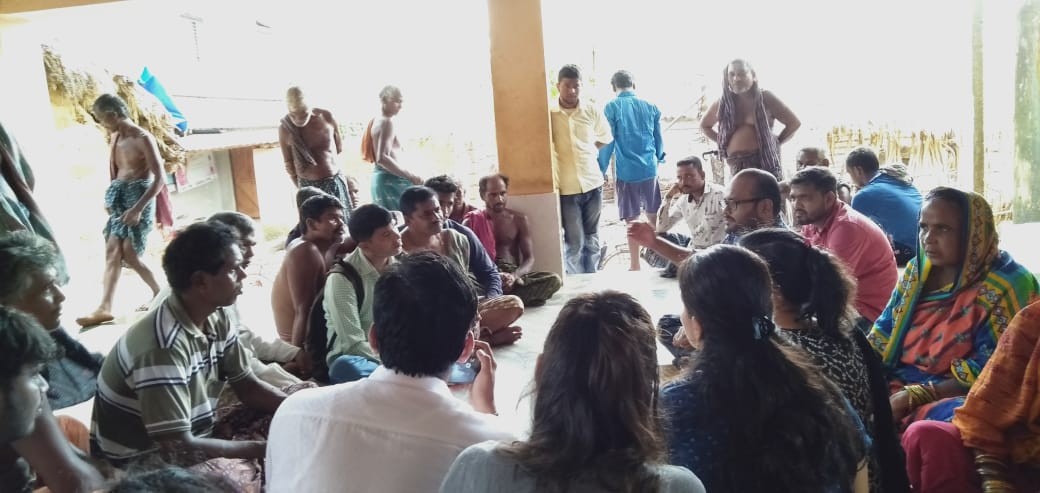
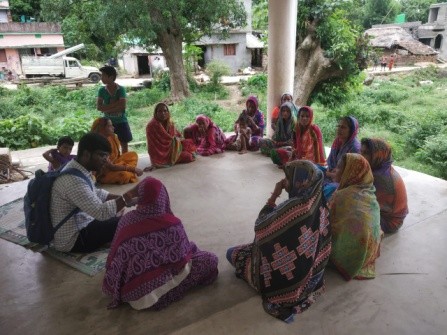
MRHRU at Namkum, Ranchi
As part of the tripartite MOU signed with the health department of the Government of Jharkhand, the Department of Health Research (DHR) has established MRHRU at Namkum in Ranchi that would function under the mentorship of ICMR-Regional Medical Research Centre (RMRC), Bhubaneswar in collaboration with MRU-Rajendra Institute of Medical Sciences, Ranchi. MRHRU-Namkum is established with an aim to bridge the gap between technology developers, health system operators, and rural beneficiaries, thereby improving healthcare in remote areas of Jharkhand. The research activities at MRHRU-Namkum is governed by the Local Research Advisory Committee (LRAC). The LRAC is an apex advisory expert body who guide the technical work, review and approve research proposals, monitor progress, and provide recommendations for all MRHRU initiatives.
Our research and initiatives are customized to address the unique needs and challenges of rural communities. We prioritize community empowerment through knowledge, awareness, and facilitating access to high-quality healthcare. MRHRU-Namkum engages in collaborative efforts with local, regional, national, and international partners, fostering synergy to amplify the impact of our research. This unit is run by a dedicated team, led by a permanent Scientist from the mentor institute as the Principal Investigator, comprised of contractual staff which includes experts in medical and non-medical fields, statisticians, research professionals, technicians, data entry operators, and supporting staff.
Objectives
MRHRU-Namkum strive to:
- Conduct Impactful Research: Undertake cutting-edge research projects addressing prevalent health issues, with a focus on the specific needs of rural populations.
- Promote Community Health: Implement evidence-based strategies to improve healthcare practices, preventive measures, and overall health awareness within the community.
- Collaborate for Change: Forge partnerships with local stakeholders, government bodies, and healthcare providers to create a collaborative network aimed at improving rural health outcomes.
Demographic Profile of Namkum
Namkum, with a population of 145,841 (Census 2011), is characterized by a unique demographic makeup. The urban-rural divide stands at 19.1% (SC-3.6%, ST-23.8%) urban and 80.9% (SC-5.5%, ST-68.5%) rural, reflecting the diverse healthcare needs of the community. With a sex ratio of 967, Namkum comprises 94 villages served by 1 CHC, 1 PHC in Dundigarh, 8 sub-centres, and 17 HWCs.
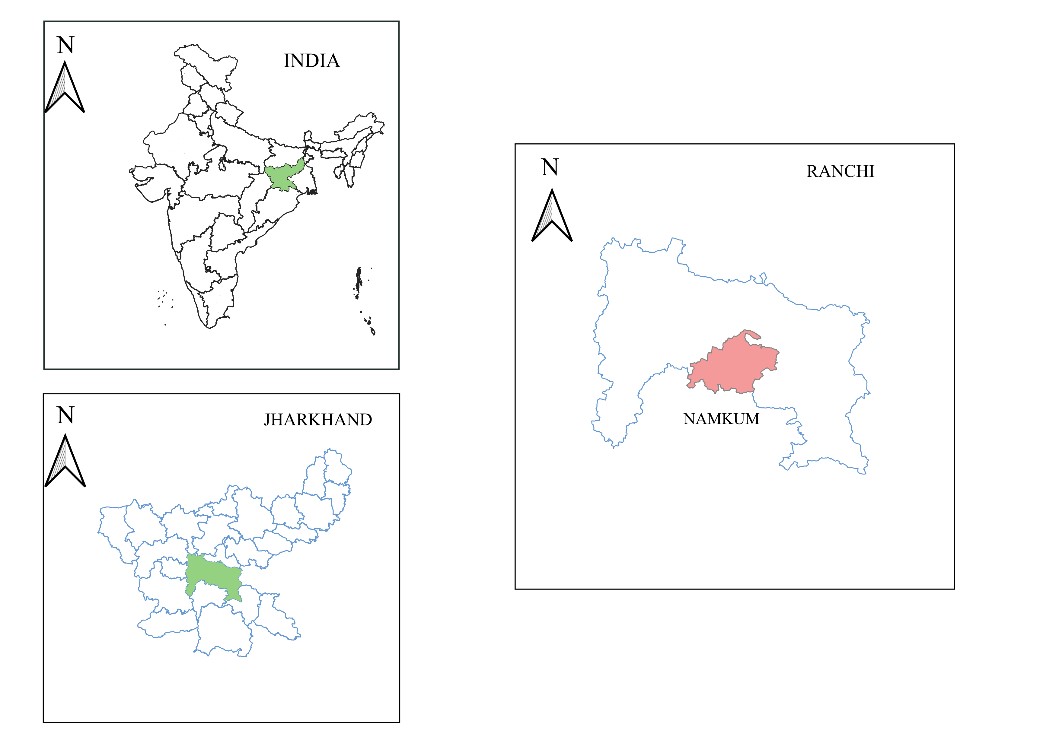
Profile of Catchment Area
The catchment area of MRHRU-Namkum, encompassing a population of 30,833, includes 1 CHC, 1 PHC, 3 sub-centres, 6 HWCs, and 19 villages.
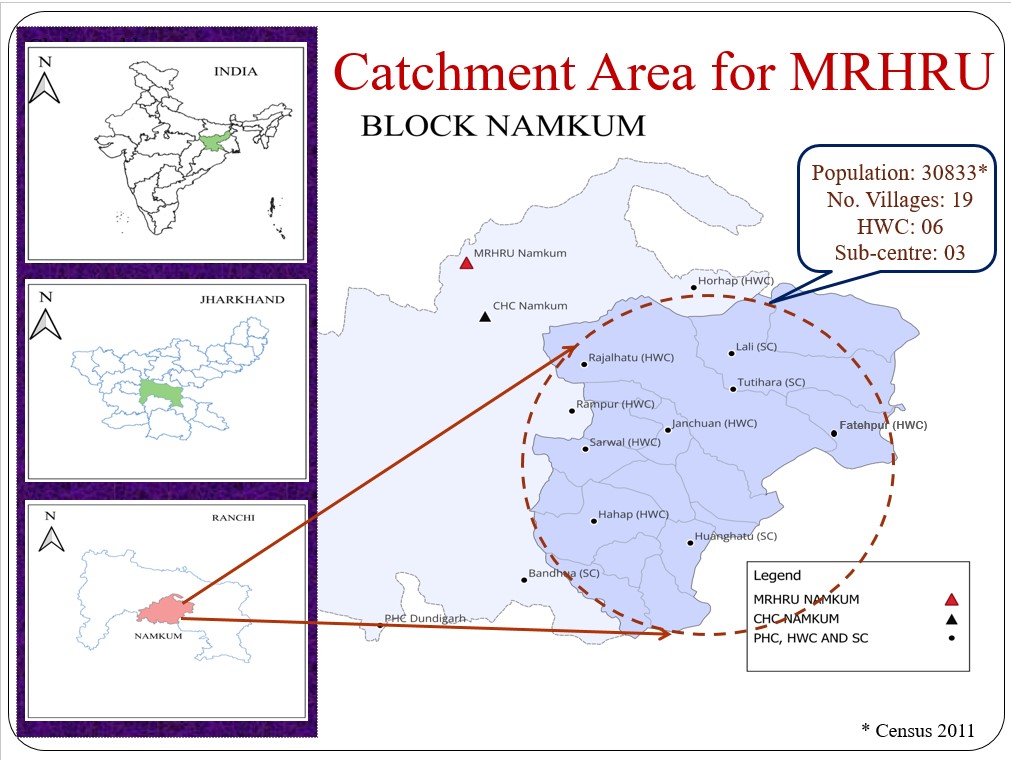
Our Team
Principal Investigator: Dr. Tanveer Rehman (Scientist-B)
Contractual Staff:
- Scientist – C (Medical)
- Scientist – C (Non-medical)
- Technical Assistant (Statistician)
- Technical Assistant (Research)
- Assistant Multipurpose
- Technician – C (Lab Technician)
- Data Entry Operator
- Group-D/MTS
Activities at MRHRU-Namkum
- Biannual LRAC meetings
- Conducting research activities: Qualitative/Quantitative/Mixed-method
- Training of Healthcare providers
- Community sensitization
- Capacity-building workshops
- Internships
- Facilitation in MD/Ph.D. theses
Laboratory Facilities
The establishment of the laboratory facility at this unit is currently in progress.
Intended Facilities:
- RT-PCR
- ELISA
- Microscopy
- Automated hematology analyser, etc.
Performance Indicators for MRHRU-Namkum
- of research studies/projects undertaken.
- of research papers published/presented/patents filed/public health relevant knowledge generated
- of transfer of new technologies.
- of clinical trials undertaken.
- of multi-centric projects undertaken
- of workshops or training conducted.
- of participants trained
Note: For inquiries and collaborations, please contact us at mrhruranchi@gmail.com or visit our office at
Stay updated on our research initiatives, and achievements by following our webpage at https://www.rmrcbbsr.gov.in/
Find us on https://maps.app.goo.gl/Bw2TKP7ua6pC1NiYA
MRHRU-Namkum Glimpses
